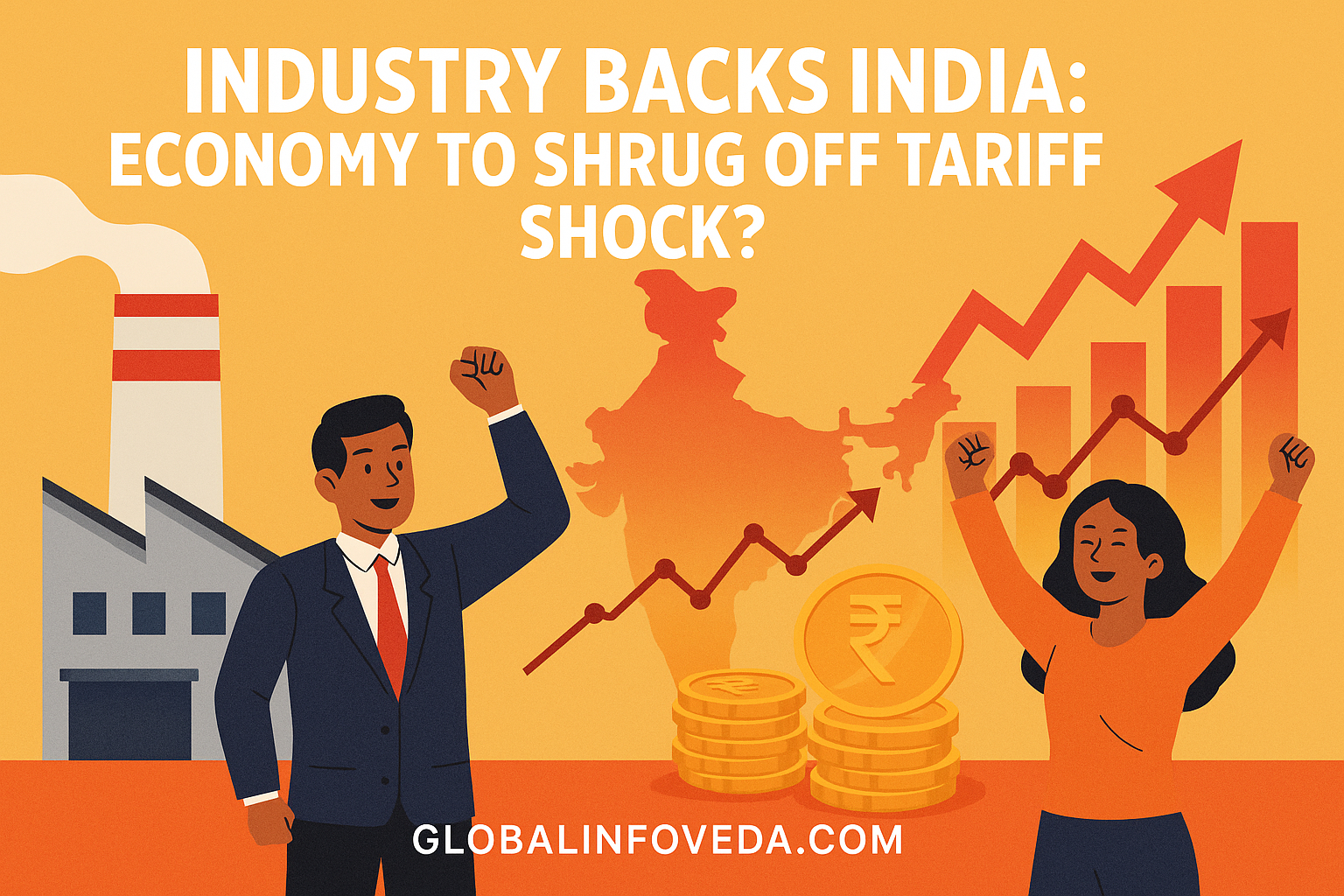Industry Backs India: Economy to Shrug Off Tariff Shock?
🏛️ Introduction: Confidence Amid Crisis
As the U.S. imposes higher tariffs on Indian exports in 2025, concerns about an economic downturn have dominated global media. The $33 billion hit seems daunting. Yet, India Inc. appears largely unfazed. From tech CEOs to grassroots MSMEs, a confident narrative is emerging: India’s economy has the scale, diversity, and adaptability to absorb this shock.
This blog explores the reasons behind the optimism, the challenges that remain, and the strategies being deployed to navigate one of India’s biggest international trade disruptions.
📊 Big Picture: How Vulnerable Is India to U.S. Tariffs?
While the U.S. is a key export destination, India’s trade dependency is relatively modest compared to peers:
- 🧮 Exports make up ~19% of India’s GDP, much lower than countries like South Korea (~38%) or Vietnam (~46%).
- 🏠 Domestic demand—consumption, real estate, infrastructure—forms over 55% of economic activity.
- 💻 India’s services exports—IT, fintech, digital transformation—are highly diversified, with EU, ASEAN, and MEA markets expanding.
📌 In 2024–25, India exported $460 billion in goods, of which $85 billion went to the U.S. The new tariff package covers only about 30–35% of that amount.
🧠 In context: Even if 100% of U.S.-bound exports were disrupted, that would represent only ~3.5% of India’s GDP.
🔍 Sectoral Exposure: Who’s Most at Risk?
Some sectors are undeniably exposed:
1. Textiles & Garments
- Nearly 35% of textile exports are U.S.-bound.
- Tariffs of 15–22% threaten margins for companies in Tiruppur, Ludhiana, and Surat.
- 👕 Garment hubs are facing potential job losses in informal manufacturing clusters.
- Industry bodies like AEPC are seeking duty drawbacks, labor subsidies, and faster FTA implementation with Europe.
2. Pharmaceuticals
- India supplies 40% of U.S. generics and is a key player in APIs (active pharmaceutical ingredients).
- While essential medicines are exempt, others now face supply chain audits, compliance hurdles, and reclassification.
- 🧪 Some firms are exploring “dual formulation” strategies—manufacturing basic ingredients in India but packaging in tariff-friendly countries.
3. Auto Parts & Engineering Goods
- SMEs in Pune, Chennai, Rajkot, and Coimbatore are feeling a squeeze.
- Tier-2 suppliers lack the buffer of large inventories and capital cushions.
- 🏭 Regional industry associations are lobbying for interest-free working capital lines and customs clearance fast-tracking.
Despite this, all three sectors are pushing for market expansion in Latin America, Africa, Eastern Europe, and ASEAN to mitigate risk.
💼 Why India Inc Remains Bullish: Five Key Reasons
✅ 1. Expanding Domestic Market
- India has 940 million active mobile users, rising rural internet penetration, and booming digital payments.
- 📦 Tier 2 and Tier 3 cities contributed over 50% of e-commerce growth in FY25, according to IAMAI.
🌍 2. Trade Diversification Strategy
- India has signed new or updated Free Trade Agreements (FTAs) with:
- UAE (2023)
- Australia (2024)
- UK (2025 ratification pending)
- Active bilateral dialogues with Canada, EU, and South Korea are underway.
- 📊 India is also moving towards currency settlement in INR with African and Central Asian nations.
🏭 3. PLI Schemes in Action
- Production Linked Incentives worth ₹3.5 lakh crore are underway in 14 sectors.
- Over 300 foreign and domestic firms have pledged capex in:
- Electronics (Apple, Samsung, Dixon)
- Solar modules (Waaree, Adani)
- Drones, textiles, specialty steel, and bulk drugs
- 📈 PLI contribution to manufacturing GVA is projected at 2.4% in FY26, up from 1.3% in FY24.
📈 4. Stable Macroeconomic Fundamentals
- GDP projected at 6.8% for FY26, down slightly from 7.2%, but still robust.
- CPI inflation at 5.1%, within RBI’s target range.
- Foreign reserves at $635 billion, enough to cover over 10 months of imports.
- 📉 Rupee has remained relatively stable at ₹83.3/USD, despite global volatility.
🏗️ 5. Private Sector Capex Surge
- Corporates like Reliance, Tata, L&T, Adani announced total capex exceeding ₹2.7 lakh crore in 2025.
- Foreign institutional investment (FII) in green energy, semiconductors, logistics, and EVs up by 35% YoY.
- 📊 New startup unicorns emerged in clean mobility and SaaS despite global funding slowdown.
🏛️ Government’s Proactive Response: Buffering the Blow
The Centre has adopted a multi-layered strategy:
1. Diplomatic Offensive
- Commerce Ministry and MEA launched a strategic trade dialogue taskforce.
- India seeking product-wise exemption negotiations based on bilateral dependence (e.g., pharma, textiles).
- Backchannel diplomacy underway with USTR and U.S. Congressional trade committees.
2. Policy Support for Affected Sectors
- Fast-tracking export tax refunds (RoDTEP, MEIS) to improve liquidity.
- Extending MSME Emergency Credit Line Guarantee Scheme (ECLGS).
- ₹10,000 crore corpus under EXIM Bank for R&D, design innovation, and market diversification.
3. Logistics & Infrastructure Boost
- ₹1.8 lakh crore PM Gati Shakti projects to reduce logistics cost from 13% to 8% of GDP.
- Unified Logistics Interface Platform (ULIP) expanding for customs digital integration.
- Dedicated tariff impact cell launched within DPIIT to monitor evolving issues.
🔮 Final Insight: Adaptation, Not Abdication
India’s resilience is built not just on scale, but on reform-driven adaptation. The tariff shock is real—but it is unlikely to derail India’s long-term growth trajectory.
📈 The real test lies in speed of structural responses, not avoidance of friction. The economy is increasingly wired for multi-polar trade, digitized supply chains, and domestic capex-led expansion.
In fact, this crisis may be the catalyst that pushes India faster toward:
- 🌱 Self-reliant supply chains
- 🤝 Balanced trade alliances
- 🔬 Next-gen manufacturing leadership
- 💼 Strong domestic capital formation
📡 Stay connected to GlobalInfoVeda.com for real-time coverage of India’s trade, industry, and policy ecosystem as it evolves through global disruptions.
